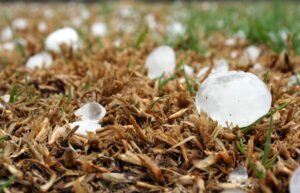
Are you ready for hail season? Springtime in the Midwest is prime time for severe storms, which can include hail if the atmospheric conditions are right. Although hail plunking down onto your roof and deck may sound soothing (or entertaining, interesting, etc.), don’t get too comfortable. Hailstorms can cause extensive, costly damage to buildings, vehicles and other property (adding up to billions of dollars), according to the National Oceanic and Atmospheric Administration (NOAA). Keep reading to learn what you can do to protect your home and other property and minimize hail damage.
Reducing the risk of hail damage
One of the largest hailstones ever reported in Illinois fell near Minooka (Kendall County) on June 10, 2015. The hailstone was 4.75 inches in diameter, larger than a softball. As you may expect, this hailstorm resulted in extensive damage to property across the area, with losses exceeding $100,000.
So, what can you do to prevent, or at least minimize, property damage from the inevitable hailstorm? Here are some suggestions:
Install a hail-resistant roof. If you are building a new home or are due for a new roof, consider installing impact-resistant roofing materials. These materials are designed to withstand hail impacts better than traditional roofing materials. Experts recommend using metal roofing or roofing with a high UL 2218 rating (Class 3 or 4). Some insurance companies offer a discount for homes with impact-resistant shingles. Check with your Bradish agent.
Inspect your roof and siding regularly. Cracked or missing shingles and damaged siding are more likely to sustain damage in a severe storm. Keep up with exterior maintenance for optimum protection.
Keep your gutters and downspouts clear of debris. If your gutters are full of leaves, twigs and other debris, the force of a hailstorm can cause them to come loose and fall off your house. Assuming your gutters remain intact, there is nowhere for melting hailstones to go if the gutters and downspout are clogged up. This could lead to gutter overflow and leaking into your basement, potentially causing water damage.
Maintain the trees on your property. Regularly trim the tree branches around your home on your property, especially those close to windows, to reduce the risk of hail causing damage during storms. Branches and even whole trees can fall on your home or vehicle.
Secure outdoor items. Move outdoor furniture, grills and other valuable items indoors or to a sheltered area to prevent them from being dented, chipped and otherwise damaged by hail. Also, moving them to a protected location will prevent them from becoming projectiles during a severe storm. To protect heavy items that are difficult to move, cover them with heavy-duty waterproof, weather-resistant covers.
Provide cover for your car. Whenever possible, park your vehicle in a garage or carport, or under a sturdy structure to provide protection from hail. If you do not have access to a covered area, invest in hail-resistant car covers. These covers are made from materials that can absorb impacts.
Stay alert and be prepared. Keep an eye on weather forecasts, especially during the spring storm season. If a storm is predicted, take the applicable precautions listed above, such as bringing outdoor furniture inside and moving your vehicle to a safer location. Learn what to do to prepare for an emergency, including creating a disaster-preparedness plan for your family and keeping a stocked emergency kit at the ready. It is entirely possible that, despite your best efforts, you could end up with damage to your home, vehicle or other property in a hailstorm. If this is the case, you will want to assess the damage as soon as possible.
Check your insurance coverage
One important part of being prepared for a hailstorm (or any severe weather) is knowing what your insurance will cover. First, does your homeowner policy include hail damage? It’s a good idea to confirm coverage. Other factors may influence your coverage as well, such as certain home improvements you may have made (see this article). Also, you should become familiar, now, with what you can do to expedite the insurance claim process.
Now that your home coverage is clarified, check your auto insurance policy. If you have comprehensive coverage, damage to your car, windshield, and even the interior of your car (did you leave the window open?) would most likely be covered. (Also, look into “full glass” protection for your windshield.) If you only have liability coverage, or collision coverage, hail damage would not be covered. The average cost to repair hail damage to a car is $2,800, according to Erie Insurance. It’s important to know to what your coverage is, so you have an idea of what to expect in a claim situation.
Your Bradish agent is here to help you get to the bottom of all of this. Feel free to reach out anytime for assistance, to make sure you have enough insurance protection in the event of a hailstorm or some other type of severe weather.
Taking steps to protect your property — and securing the appropriate insurance coverage — just might make the next hailstorm simply an interesting weather phenomenon instead of an occasion for worry.
by Kris A. Mainellis